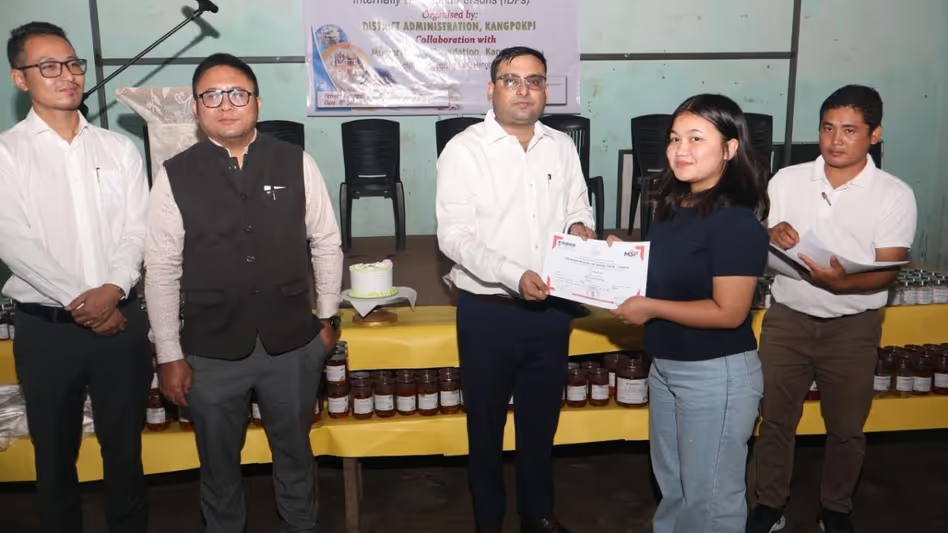Empowering Displaced Families: Inside Manipur’s Kangpokpi Skill Development Initiative
A three-week‑long Skill Development Training Program for displaced family members in Kangpokpi district, Manipur, wrapped up at the Sandang Shenba Maring Community Hall. The initiative, which began on June 17, 2025, saw approximately 160 trainees participate, equipping them with practical skills to boost employability and rebuild livelihoods. The ceremony was honored by key dignitaries, government officials, and organizers who highlighted the program as a constructive step in the region’s socio-economic recovery
Introduction: A Ray of Hope Amid Displacement
Ever wondered how a community bounces back from displacement? Imagine being uprooted—security, routine, livelihood all gone. That’s where programs like the one in Kangpokpi step in. This is not just about learning sewing or tech; it’s about rebuilding hope and self-reliance. In this article, we’ll explore why this initiative matters, what it achieved, and how it’s shaping brighter futures in Manipur.
1. Why This Training Program Was Crucial
a. Addressing Displacement Challenges
When families are displaced—due to conflict, disaster, or economic factors—they often lose their primary livelihood. Unemployment leads to dependency, stress, and lost dignity. This program offers a lifeline.
b. Economic Self-Reliance
By teaching market-relevant skills, participants gain tools to support themselves. This translates to small businesses, trades, or remote work—restarting economic engines one individual at a time.
c. Emotional & Social Reintegration
Learning in a group builds community bonds. It combats isolation, restores routine, and gives people back their sense of purpose and identity.
2. The Program at a Glance
a. Timeline & Venue
- Duration: June 17 – early July 2025 (~3 weeks)
- Venue: Sandang Shenba Maring Community Hall, Kangpokpi district
b. Who Took Part
- Approx. 160 trainees, primarily from displaced households.
- Inclusive of varying genders, ages, and skill levels.
c. Curriculum & Skill Areas
While exact modules weren’t detailed, similar programs typically include:
- Tailoring & embroidery
- Basic computer literacy
- Candle‑making, baking, handicrafts
- Soft skills: communication, budgeting, entrepreneurship
d. Organizers & Supporters
- Local government bodies
- NGOs focused on youth and women’s empowerment
- Community leaders
- Possibly Assam Rifles and BVG India Ltd collaborations
3. Graduation: More Than a Ceremony
The graduation was a symbolic milestone:
a. Recognition & Confidence
Participants showcased their work—stitching samples, bakery goods, computer projects. It fueled pride and affirmed their progress.
b. Dignitaries’ Role
Local officials spoke, likely discussing future business support, market access, and potential financial aid.
c. Networking & Next Steps
Families engaged with potential employers, local businesses, or cooperative partners. This social capital is as valuable as the skills learned.
Conclusion: A Stitch in Time
In times of crisis, it’s brave souls, community spaces, and targeted training that light the path forward. Kangpokpi’s program is more than a classroom—it’s a launchpad for self-respect, stability, and a resilient future.
When displaced families find renewed purpose, everyone benefits—children get schooling, economies revive, hope rebuilds. And while the program may have lasted just three weeks, its effects could last a lifetime.
Frequently Asked Questions (FAQs)
1. Who funded the Kangpokpi skill program?
While press mentions government and NGOs, official funding and supporting partners weren’t fully disclosed.
2. What specific skills were taught?
Details are limited, but such programs usually include tailoring, computer basics, crafting, and small-scale entrepreneurship.
3. Did trainees receive financial support?
The report doesn’t mention direct capital support; graduates may still need micro-loans or grants to start businesses.
4. How will success be tracked?
Though no monitoring details were shared, success metrics could include income improvement, business launch rate, and job placements.
5. Can this program expand to other districts?
Absolutely! With government backing and community engagement, it can be adapted to similar contexts across the region.



